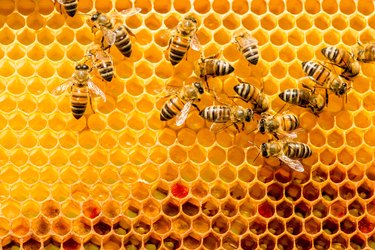Discovering you've been sharing your home with bees can be an alarming realization. Part of you knows how important they are for the environment, but another part of you worries about being stung or incurring home damage from their hive activity. The best thing to do is to relocate the bees. This win-win solution keeps you and your family safe, protects your home and preserves a threatened species in the environment. However, let the professionals tackle this job. Both you and the bees could get hurt if the hive is not relocated with great care.

Video of the Day
Are They Bees or Wasps?
If your winged home invaders are actually wasps, you can call an exterminator. Before you pick up the phone, carefully try to determine which insect you have. Wasps and bees are similar in size and have black stripes on a yellow back, but wasps are far more aggressive and are more likely to sting you. Proceed with caution while attempting to identify the insect.
Video of the Day
A wasp's body usually looks shiny and brightly colored, while a bee's hairy body looks dull and gives the impression of only a dusting of color. Wasps also have a narrow waist, whereas bees appear round from head to stinger, with only slight indentations at the neck and waist. Even their legs are different: Wasps have long, slender, hairless legs, and bees have fuzzy squat legs.
Bees and wasps also can differ. Wasps typically create nests on a home's exterior. They might look honeycomb shaped or like a cone of mud. But if you see multiple insects flying in and out of a crevice in your home, you likely have a colony of bees living in the hollow space inside (although wasps can build nests inside soffits and other hidden cavities). A bee's nest remains hidden within the crevices of the home, but visible portions will have a telltale honeycombed appearance.
If you see a huge swarm of large winged insects on your home, car or a tree branch, you're definitely looking at bees, not wasps.
Why Do Bees Like Soffits?
The soffit is the enclosed area underneath an eave, archway, balcony or any other overhanging structure on a house. There is usually little to no insulation in this area, so the space is hollow and the perfect environment for bees to create a wild nest. The hollow area inside a soffit is also large enough to accommodate large combs and an expansive hive with tens of thousands of bees living in it at any given time.
Fortunately, it's easy to access a soffit cavity for bee removal. The underside is usually comprised of a flat sheet of plywood, vinyl or aluminum that comes off easily. The bee professionals will take care of this themselves, because the bees might get agitated and sting if the handler has not taken proper precautions. Fortunately, these experts also typically replace any materials removed for bee retrieval. Depending on construction, a soffit may also be accessible through the interior of the house, such as via the attic.
What to Expect During Nest Removal and Relocation
The first thing bee professionals will do is inspect the area to determine the bees' entry and exit points. They can also tap on the soffit to determine the location of the nest. After calming the bees with smoke, they remove the soffit covering to expose the nest.
From this point on, bee professionals might select different strategies to remove and relocate the bees. Typically, they use a special bee vacuum designed to keep the insects as safe as possible. The combs can then be methodically cut out and placed in a bee box along with the vacuumed bees.
The goal of the bee box is to give the bees a place to congregate as a unit and to make for easy transport. But the bees will not stay together unless they are with the queen bee, which emits pheromones that draw the bees to her for protection.
Therefore, the queen bee must be specifically located and trapped in a smaller box to prevent her from flying away. Professionals may trap her by hand, but sometimes she ends up in the vacuum and the bee box.
Once the bee removal experts have vacuumed most of the bees into the bee box and cut out all of the combs, they will spray the soffit with a bee repellent to prevent bees from returning to the area to form a new nest. Next, they close the soffit and seal it with caulk for extra protection against future invasion. They use materials that are unlikely to suffer damage from natural forces or other wild animals, such as galvanized steel or a thick hardwood with a waterproof stain.
Finally, the bees are usually transported to a beekeeper for care and safekeeping, as this prevents them from forming another nuisance nest in another person's home.